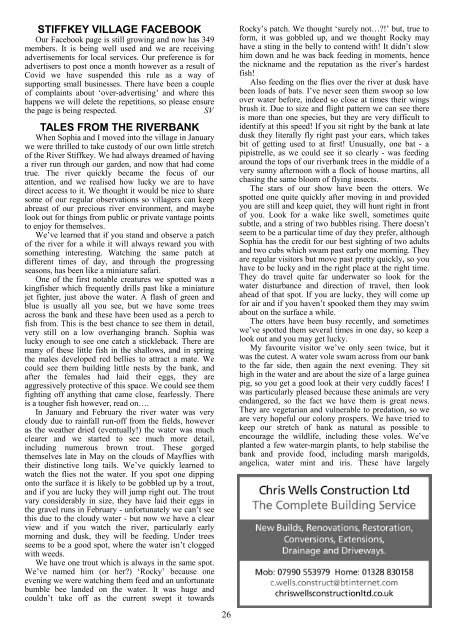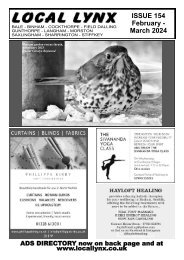Local Lynx No.140 - October/November 2021
The community newspaper for 10 North Norfolk villages.
The community newspaper for 10 North Norfolk villages.
You also want an ePaper? Increase the reach of your titles
YUMPU automatically turns print PDFs into web optimized ePapers that Google loves.
STIFFKEY VILLAGE FACEBOOK<br />
Our Facebook page is still growing and now has 349<br />
members. It is being well used and we are receiving<br />
advertisements for local services. Our preference is for<br />
advertisers to post once a month however as a result of<br />
Covid we have suspended this rule as a way of<br />
supporting small businesses. There have been a couple<br />
of complaints about ‘over-advertising’ and where this<br />
happens we will delete the repetitions, so please ensure<br />
the page is being respected.<br />
SV<br />
TALES FROM THE RIVERBANK<br />
When Sophia and I moved into the village in January<br />
we were thrilled to take custody of our own little stretch<br />
of the River Stiffkey. We had always dreamed of having<br />
a river run through our garden, and now that had come<br />
true. The river quickly became the focus of our<br />
attention, and we realised how lucky we are to have<br />
direct access to it. We thought it would be nice to share<br />
some of our regular observations so villagers can keep<br />
abreast of our precious river environment, and maybe<br />
look out for things from public or private vantage points<br />
to enjoy for themselves.<br />
We’ve learned that if you stand and observe a patch<br />
of the river for a while it will always reward you with<br />
something interesting. Watching the same patch at<br />
different times of day, and through the progressing<br />
seasons, has been like a miniature safari.<br />
One of the first notable creatures we spotted was a<br />
kingfisher which frequently drills past like a miniature<br />
jet fighter, just above the water. A flash of green and<br />
blue is usually all you see, but we have some trees<br />
across the bank and these have been used as a perch to<br />
fish from. This is the best chance to see them in detail,<br />
very still on a low overhanging branch. Sophia was<br />
lucky enough to see one catch a stickleback. There are<br />
many of these little fish in the shallows, and in spring<br />
the males developed red bellies to attract a mate. We<br />
could see them building little nests by the bank, and<br />
after the females had laid their eggs, they are<br />
aggressively protective of this space. We could see them<br />
fighting off anything that came close, fearlessly. There<br />
is a tougher fish however, read on….<br />
In January and February the river water was very<br />
cloudy due to rainfall run-off from the fields, however<br />
as the weather dried (eventually!) the water was much<br />
clearer and we started to see much more detail,<br />
including numerous brown trout. These gorged<br />
themselves late in May on the clouds of Mayflies with<br />
their distinctive long tails. We’ve quickly learned to<br />
watch the flies not the water. If you spot one dipping<br />
onto the surface it is likely to be gobbled up by a trout,<br />
and if you are lucky they will jump right out. The trout<br />
vary considerably in size, they have laid their eggs in<br />
the gravel runs in February - unfortunately we can’t see<br />
this due to the cloudy water - but now we have a clear<br />
view and if you watch the river, particularly early<br />
morning and dusk, they will be feeding. Under trees<br />
seems to be a good spot, where the water isn’t clogged<br />
with weeds.<br />
We have one trout which is always in the same spot.<br />
We’ve named him (or her?) ‘Rocky’ because one<br />
evening we were watching them feed and an unfortunate<br />
bumble bee landed on the water. It was huge and<br />
couldn’t take off as the current swept it towards<br />
26<br />
Rocky’s patch. We thought ‘surely not…?!’ but, true to<br />
form, it was gobbled up, and we thought Rocky may<br />
have a sting in the belly to contend with! It didn’t slow<br />
him down and he was back feeding in moments, hence<br />
the nickname and the reputation as the river’s hardest<br />
fish!<br />
Also feeding on the flies over the river at dusk have<br />
been loads of bats. I’ve never seen them swoop so low<br />
over water before, indeed so close at times their wings<br />
brush it. Due to size and flight pattern we can see there<br />
is more than one species, but they are very difficult to<br />
identify at this speed! If you sit right by the bank at late<br />
dusk they literally fly right past your ears, which takes<br />
bit of getting used to at first! Unusually, one bat - a<br />
pipistrelle, as we could see it so clearly - was feeding<br />
around the tops of our riverbank trees in the middle of a<br />
very sunny afternoon with a flock of house martins, all<br />
chasing the same bloom of flying insects.<br />
The stars of our show have been the otters. We<br />
spotted one quite quickly after moving in and provided<br />
you are still and keep quiet, they will hunt right in front<br />
of you. Look for a wake like swell, sometimes quite<br />
subtle, and a string of two bubbles rising. There doesn’t<br />
seem to be a particular time of day they prefer, although<br />
Sophia has the credit for our best sighting of two adults<br />
and two cubs which swam past early one morning. They<br />
are regular visitors but move past pretty quickly, so you<br />
have to be lucky and in the right place at the right time.<br />
They do travel quite far underwater so look for the<br />
water disturbance and direction of travel, then look<br />
ahead of that spot. If you are lucky, they will come up<br />
for air and if you haven’t spooked them they may swim<br />
about on the surface a while.<br />
The otters have been busy recently, and sometimes<br />
we’ve spotted them several times in one day, so keep a<br />
look out and you may get lucky.<br />
My favourite visitor we’ve only seen twice, but it<br />
was the cutest. A water vole swam across from our bank<br />
to the far side, then again the next evening. They sit<br />
high in the water and are about the size of a large guinea<br />
pig, so you get a good look at their very cuddly faces! I<br />
was particularly pleased because these animals are very<br />
endangered, so the fact we have them is great news.<br />
They are vegetarian and vulnerable to predation, so we<br />
are very hopeful our colony prospers. We have tried to<br />
keep our stretch of bank as natural as possible to<br />
encourage the wildlife, including these voles. We’ve<br />
planted a few water-margin plants, to help stabilise the<br />
bank and provide food, including marsh marigolds,<br />
angelica, water mint and iris. These have largely

















